#nesarc
Explore tagged Tumblr posts
Text
Exploring the Link Between Early Smoking Initiation and Nicotine Dependence – A NESARC Data Analysis

Dataset
For this project, I selected the NESARC Wave 1 dataset, a nationally representative survey focused on substance use and mental health issues among U.S. adults.
Research Topic
I'm interested in exploring whether the age someone starts smoking impacts their likelihood of developing nicotine dependence.
Selected Variables
S3AQ3B1 – Age respondent first smoked a cigarette
S3AQ3C1 – Frequency of smoking in the past 12 months
S3BQ1A5 – Diagnosed with nicotine dependence (DSM-IV criteria)
Research Questions
Does starting to smoke at a younger age increase the risk of developing nicotine dependence?
At what age does the risk become significantly higher?
Summary
This study looks into the potential link between early smoking behavior and later addiction. By focusing on the age of smoking initiation and diagnosis of nicotine dependence, the goal is to highlight how early interventions could change addiction outcomes in adulthood.
Literature Review
Prior research supports a strong connection between early smoking and later dependence:
Kandel & Chen (2000) showed that the earlier individuals start smoking, the greater their risk of developing heavy smoking habits and nicotine dependence.
Breslau et al. (1998) emphasized that younger initiation age predicts more difficulty quitting and higher addiction severity.
References
Kandel, D. B., & Chen, K. (2000). Extending adolescent smoking patterns into adulthood: The link between early onset and later nicotine dependence. American Journal of Public Health, 90(5), 692–695.
Breslau, N., Peterson, E. L., & Schultz, L. R. (1998). Smoking cessation in young adults: Age at initiation of cigarette smoking and other suspected influences. Preventive Medicine, 27(2), 217–224.
Hypothesis
"Individuals who begin smoking earlier are more likely to develop nicotine dependence compared to those who start later."
"Decode the numbers. Discover the story."
5 notes
·
View notes
Text
EXPLORANDO LAS PROFUNDIDADES DEL ALCOHOLISMO Y SU IMPACTO EN LA SALUD MENTAL
Adentrándome en el vasto mundo de los datos del estudio NESARC (National Epidemiologic Survey on Alcohol and Related Conditions), me encontré inmerso en un océano de posibilidades para la investigación. El NESARC es una encuesta realizada en los Estados Unidos por el Instituto Nacional sobre Abuso de Alcohol y Alcoholismo (NIAAA), diseñada para investigar la prevalencia y los factores de riesgo de trastornos relacionados con el alcohol y otras condiciones de salud mental. Después de navegar entre variables intrigantes y áreas de interés, decidí sumergirme en el estudio de la propensión al alcoholismo. Pero no me detuve ahí. Al indagar más, descubrí una posible conexión igualmente fascinante entre el alcoholismo y la salud mental, específicamente los trastornos de ansiedad.
Explorando la Propensión al Alcoholismo:
Mi enfoque inicial se centrará en desentrañar los hilos que conectan el historial familiar, la depresión, el consumo de tabaco y la ludopatía con la propensión al alcoholismo. ¿Cómo se entrelazan estas variables? ¿Qué papel desempeñan en el desarrollo de la adicción al alcohol? Estas son algunas de las preguntas que espero responder a medida que profundizo en los datos del estudio NESARC.
Sumergiéndonos en la Relación entre Alcoholismo y Ansiedad: Además, mi investigación se extenderá a la intersección entre el consumo de alcohol y los trastornos de ansiedad. ¿Existe una conexión directa entre ambos? ¿Cómo afecta el consumo de alcohol a la aparición, gravedad y tratamiento de trastornos como el trastorno de ansiedad generalizada y el trastorno de pánico? Estas son las preguntas que me guiarán mientras exploramos los datos recopilados por el estudio NESARC
Variables Clave y Preguntas de Investigación:
Factores de riesgo y protectores para el alcoholismo: ¿Cuáles son los factores de riesgo y protección asociados con la propensión al alcoholismo? Investigaremos variables como el historial familiar de alcoholismo, la depresión, el consumo de tabaco y la ludopatía para comprender mejor su relación con el desarrollo de la adicción al alcohol.
Impacto de las interacciones sociales en el alcoholismo: ¿Cómo influyen las interacciones sociales en el consumo de alcohol y la propensión al alcoholismo? Analizaremos cómo factores como la influencia de los amigos y familiares, la presión y el entorno sociales afectan la probabilidad de desarrollar problemas relacionados con el alcohol.
Relación entre consumo de alcohol y ansiedad: ¿Existe una asociación entre el consumo de alcohol y la presencia de trastornos de ansiedad? Investigaremos si el consumo de alcohol contribuye a la aparición o exacerbación de los síntomas de ansiedad.
Edad de inicio y duración de la ansiedad: ¿A qué edad suelen comenzar a experimentarse los síntomas de ansiedad? ¿Cuánto tiempo suelen durar estos síntomas? Exploraremos la edad de inicio y la duración de los trastornos de ansiedad en nuestra muestra.
Las variables que se utilizarán para el estudio se pueden consultar en el siguiente documento:
LIBRO DE CÓDIGO.pdf
Revisión Bibliográfica:
Allende, S. (2009). Impacto de la genética en el alcoholismo. Un enfoque desde la lógica difusa. Rev hanan cienc méd La Habana.
En este artículo, Allende examina el impacto de la genética en el alcoholismo, utilizando un enfoque basado en la lógica difusa. Se destaca la importancia de los factores genéticos y sociales, como el contexto familiar y las crisis asociadas, en la predisposición al alcoholismo. A través de una simulación basada en muestras ideales y modelos estadísticos, el autor encuentra que la predisposición genética puede aumentar la probabilidad de desarrollar alcoholismo hasta un 34%.
González-González, A., et al. (2012). Depresión y consumo de alcohol y tabaco en estudiantes de bachillerato y licenciatura. Salud mental, 35(1), 51-55.
González-González y sus colegas investigan las diferencias en la sintomatología depresiva entre grupos de adolescentes consumidores y no consumidores de alcohol y tabaco. Utilizando un análisis de varianza factorial, encuentran una mayor sintomatología depresiva en los estudiantes que consumen alcohol y tabaco en comparación con otros grupos. Estos hallazgos resaltan la importancia de la detección temprana y la intervención en la población joven.
Montalvo, J. F., et al. (2005). Prevalencia del juego patológico en el alcoholismo: un estudio exploratorio. Revista de psicopatología y psicología clínica, 10(2), 125-134.
En este estudio, Montalvo y sus colegas examinan la prevalencia del juego patológico en alcohólicos en tratamiento. Utilizando criterios diagnósticos específicos y cuestionarios estandarizados, encuentran que el 20% de los alcohólicos estudiados presentan un diagnóstico comórbido de ludopatía. Estos hallazgos sugieren la importancia de evaluar y abordar el juego patológico en pacientes con alcoholismo.
De Pablo, J., et al. (2002). Análisis de comorbilidad entre síndrome de dependencia del alcohol y ludopatía en pacientes en tratamiento en centros de salud mental. Anales del Sistema Sanitario de Navarra, 25(1), 31-36.
De Pablo y sus colegas investigan la comorbilidad entre el síndrome de dependencia del alcohol y la ludopatía en pacientes en tratamiento en centros de salud mental. Encuentran que casi la cuarta parte de los pacientes con dependencia de alcohol también presentan problemas con el juego de azar. Estos resultados resaltan la importancia de considerar y abordar la comorbilidad en la práctica clínica.
Torres, A. B. M., et al. (2017). La evaluación psicofisiológica de ansiedad en el síndrome de abstinencia alcohólica: estudio de caso. Revista Electrónica de Psicología Iztacala, 20(1), 115-138.
Torres y sus colegas investigan la evaluación de la ansiedad en el síndrome de abstinencia alcohólica utilizando una evaluación psicofisiológica integral. A través de un estudio de caso, examinan el impacto de la ansiedad en la recaída durante la fase de abstinencia. Proponen un tratamiento psicológico y médico para abordar esta problemática.
Conclusión:
A medida que nos sumergimos en estas áreas de investigación, espero arrojar luz sobre la compleja relación entre el alcoholismo y la salud mental. Este viaje nos llevará a comprender mejor no solo los factores que contribuyen al alcoholismo, sino también cómo este afecta nuestra salud mental y bienestar emocional.
Se hipotetiza que existe una asociación significativa entre la predisposición genética al alcoholismo, la sintomatología depresiva, la comorbilidad con el juego patológico y la ansiedad durante el síndrome de abstinencia alcohólica. Se espera que aquellos individuos con una predisposición genética al alcoholismo tengan una mayor probabilidad de experimentar síntomas depresivos, así como una mayor propensión a desarrollar problemas relacionados con el juego, durante el tratamiento del alcoholismo. Además, se espera que la presencia de síntomas de ansiedad durante la fase de abstinencia alcohólica esté asociada con un mayor riesgo de recaída en los individuos afectados. Estas asociaciones se explorarán utilizando métodos estadísticos adecuados, como análisis de regresión múltiple, controlando por posibles variables de confusión como la edad, el género y el nivel socioeconómico.
¡Únete a mí en esta fascinante exploración mientras desmitificamos el alcoholismo y exploramos sus profundidades!
2 notes
·
View notes
Text
Drug Use and Behavior Problems Among Youth
I chose to work with the NESARC dataset (National Epidemiologic Survey on Alcohol and Related Conditions) because it contains rich data on substance use, mental health, and personal experiences across different age groups. I selected this dataset because I want to explore how drug use among young people may be linked to behavioral problems.
How I Chose My Topic: As someone passionate about public health, I’ve been noticing a worrying trend, many young people today are getting involved with drugs at an early age. This is not just about addiction—I’m also concerned about how drug use may lead to fights, school issues, and problems at home. That’s why I decided to explore the connection between youth drug use and behavioral issues.
Research Question
Is there a relationship between drug use and behavior problems among young people?
Topics I Chose to Study
Main Topic (Independent Variable): Drug use among youth
Second Topic (Dependent Variable): Behavioral problems (e.g., fighting, skipping school, disobeying parents)
My Personal Codebook: I went through the NESARC codebook and selected only the pages related to my two topics. These pages form my personal codebook.
Codebook Pages Printed:
Section 1 (Age/Demographics): Pages 1–29
Section 3C (Drug Use & Impact): Pages 125–144
Section 11A (Behavioral Outcomes): Pages 419–436
Variables Selected
S3CQ12A1 (Section 3C)
S3CQ12A4 (Section 3C)
S11AQ1A1 (Section 11A)
S11AQ1A2 (Section 11A)
S11AQ1A4 (Section 11A)
AGE (Section 1)
Literature Review
To support my research question, I reviewed two academic articles related to youth drug use and behavior problems.
1. Disruptive Behavior Disorders and Substance Use in Adolescents
🔗 Clark & Winters, 2000 – Taylor & Francis This article explains that many teens who use drugs also show disruptive behaviors like fighting or skipping school. These behaviors may appear before or along with drug use, and they make addiction harder to treat. The authors recommend therapy and early interventions.
2. Substance Abuse in Young People
🔗 McArdle & McKenzie, 2011 – Cambridge.org This article looks at how substance use in teens often leads to behavior and mental health problems. It also talks about how many prevention programs fail due to poor implementation and follow-up. It recommends stronger, evidence-based approaches for helping young people.
Search Terms Used:
"youth drug use and behavior"
"substance abuse and behavior problems in adolescents"
"adolescent drug use and school trouble"
Hypothesis
Young people who report drug use are more likely to experience behavior problems such as fighting, skipping school, or having trouble at home or school.
#NESARC#PublicHealth#YouthHealth#SubstanceUse#DrugUseinTeens#BehavioralHealth#HealthData#HealthResearch#YouthandDrugs#DataAnalysis#HealthBlog#PublicHealthStudent#AdolescentBehavior#HealthEquity#HealthEducation#Coursera#WesleyanUniversity#ResearchProject#PublicHealthVoice#OurHealth
1 note
·
View note
Text
🧠💸 Does Money Predict Parenthood?
Just ran a Pearson correlation between total personal income (S1Q10A) and number of children under 18 in the household (CHLD0_17) using the NESARC dataset. The result?
r = -0.016 p = 0.0009
💥 Yes, it's statistically significant. 😅 But practically? Not so much.

This teeny-tiny negative correlation means higher income is slightly linked to fewer kids—but the effect is so small it’s basically a shrug from the universe. 🤷♂️📉
In short: Money ≠ more (or fewer) children — at least not in any meaningful way.
in case you want to try out the code:
import pandas as pd import numpy as np import seaborn as sns import scipy.stats import matplotlib.pyplot as plt
Load the data
data = pd.read_csv('nesarc.csv', low_memory=False)
Convert to numeric properly
data['CHLD0_17'] = pd.to_numeric(data['CHLD0_17'], errors='coerce') data['S1Q10A'] = pd.to_numeric(data['S1Q10A'], errors='coerce')
Drop rows with NA in either of the two columns
data_clean = data[['S1Q10A', 'CHLD0_17']].dropna()
Scatterplot
sns.regplot(x="S1Q10A", y="CHLD0_17", fit_reg=True, data=data_clean) plt.xlabel('Total Personal Income (USD)') plt.ylabel('Number of Children Under 18 in Household') plt.title('Scatterplot: Income vs. Number of Children') plt.show()
Pearson correlation
print('Association between S1Q10A (income) and CHLD0_17 (number of children):') r, p = scipy.stats.pearsonr(data_clean['S1Q10A'], data_clean['CHLD0_17']) print(f"Pearson r = {r:.4f}, p-value = {p:.4e}")
0 notes
Text
Exploring the Link Between Socioeconomic Status and Nicotine Dependence
Sakshi Mohan Pandey 24th April 2025 Data Analysis and Interpretation Capstone
Chosen Data Set
For this project, I’ve selected the NESARC Wave 1 dataset, which offers a rich source of nationally representative data on alcohol and drug use, as well as mental health issues among adults in the U.S. One particularly comprehensive section of the codebook deals with Tobacco Use and Dependence, which aligns closely with my interests in public health and behavioral science.
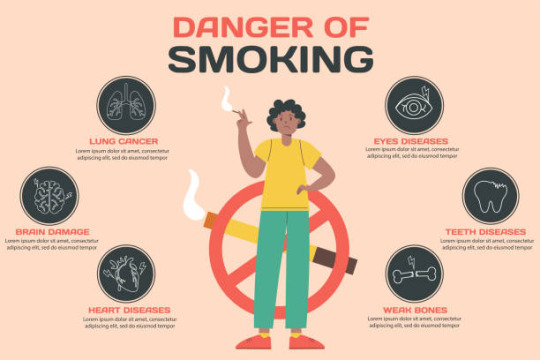
Topic of Interest
After reviewing the codebook, I became interested in exploring nicotine dependence. This condition can have serious health consequences, and understanding the contributing factors is key to effective prevention and intervention.
My Codebook
I’ve created a personal codebook including key variables from the NESARC relevant to nicotine dependence. These include:
S3AQ3C1: Frequency of cigarette smoking in the past 12 months
S3AQ3C2: Average number of cigarettes smoked per day
S3AQ3B1: Age at first cigarette
TAB12MDX: DSM-IV diagnosis of nicotine dependence
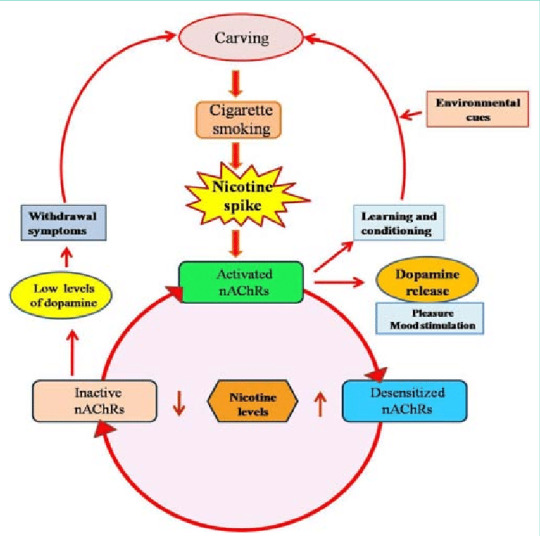
Second Topic – Socioeconomic Status
For a richer analysis, I decided to explore how socioeconomic status (SES) might influence nicotine dependence. SES is frequently cited as a determinant in health disparities, and smoking is no exception.
SES Variables Added to Codebook
I selected the following SES-related variables:
S1Q6A: Highest grade/year of education completed
S1Q10B: Personal income category
S1Q7A1 & S1Q7A2: Full-time or part-time employment status.
Literature Review
Using search terms like "nicotine dependence and socioeconomic status", "smoking behavior and income", and "education and tobacco use", I consulted Google Scholar and found several insightful studies:
Hiscock et al. (2012) demonstrated that smoking prevalence is higher in lower SES groups.
Barbeau et al. (2004) explored how education impacts tobacco use over time.
Reid et al. (2010) found a strong correlation between income level and daily cigarette consumption.
These studies suggest a consistent trend: lower SES is associated with higher rates of nicotine dependence, due to both increased initiation and reduced cessation success.

Hypothesis
Individuals with lower levels of education and income are more likely to exhibit higher levels of nicotine dependence, as defined by frequency and quantity of cigarette consumption and DSM-IV criteria.
Conclusion
This initial exploration has set the foundation for a deeper analysis into how social and economic structures can impact health behaviors like smoking. By leveraging the NESARC dataset, I aim to contribute to the conversation on how targeted interventions can reduce nicotine dependence in vulnerable populations.

#research project#Nicotinedependence#tobacco free nicotine#mental health#socioeconomic#NESARC#HealthPyschology#Health Behaviour Theory
1 note
·
View note
Text
Asociación del consumo de alcohol en la adolescencia y el trabajo en la vida adulta
Introducción a árbol de decisiones
Para esta actividad, se utilizó la base de datos del NESARC con la siguiente pregunta de investigación: ¿Qué efecto tiene la edad de inicio del consumo de alcohol en la situación laboral en la vida adulta?
La variable explicativa es la edad de inicio del consumo de alcohol (S2BQ2D, cuantitativa)
La variable de respuesta es el tipo de ocupación (S1Q9C, categórica)
Bibliotecas utilizadas
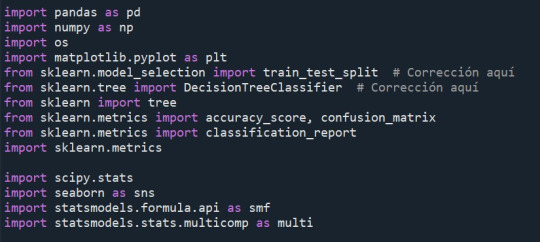
Instrucciones y variables
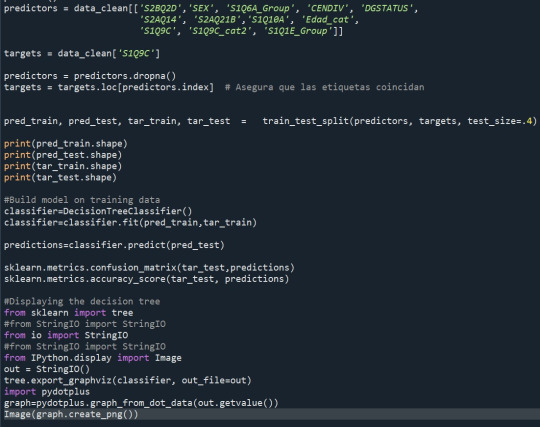
Arbol de decisiones
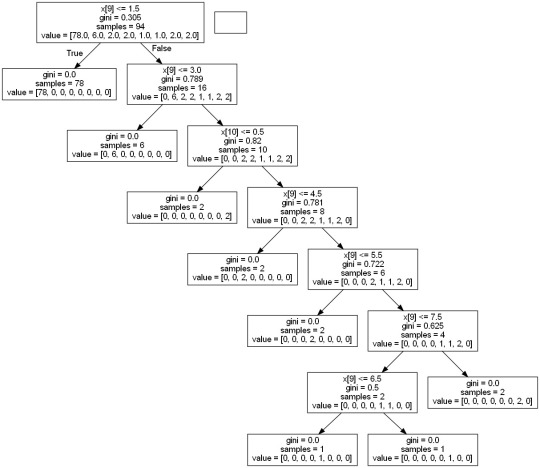
Conclusiones
El árbol de decisión ha encontrado que la categoría dominante es "Nunca ha trabajó".
Las ocupaciones gubernamentales, de negocio propio o empresariales aparecen en nodos más mezclados con mayor diversidad (gini alto).
Algunos nodos finales tienen gini = 0.0, lo que significa que todas las muestras en ese nodo pertenecen a una sola ocupación.
0 notes
Text
Revisión de la entrada del blog de Esteban Barrera
Título del blog: Explorando los Factores Asociados a la Depresión Mayor en la Población Adulta de los Estados Unidos: Un Análisis del Estudio NESARC
Estudiante: [Esteban Barrera Vazquez]
Comentarios:
1. Título del proyecto y pregunta de investigación:
El título del proyecto es claro y conciso, y refleja bien el tema de la investigación.
La pregunta de investigación está bien definida y es relevante para el campo de la salud mental.
2. Motivación y fundamento:
El estudiante proporciona una motivación clara y convincente para la investigación.
Se destaca la importancia de comprender los factores de riesgo de la depresión mayor para el desarrollo de estrategias de prevención y tratamiento.
Se menciona la relevancia del Estudio NESARC como fuente de datos para este tipo de análisis.
3. Métodos:
La descripción de la muestra es completa e incluye información sobre la población original, los criterios de selección y las características de la muestra final.
Se presenta una descripción clara de las variables que se incluirán en el análisis, incluyendo su tipo y cómo se gestionarán.
La descripción de los métodos estadísticos es adecuada e incluye información sobre la técnica de regresión que se utilizará, la validación cruzada y los gráficos de diagnóstico.
Fortalezas:
La entrada del blog está bien organizada y escrita de manera clara y concisa.
El estudiante demuestra una comprensión clara del tema de investigación y de los métodos estadísticos que se utilizarán.
Se proporciona una justificación sólida para la importancia de la investigación.
Áreas de mejora:
Se podrían ampliar un poco más las implicaciones potenciales de responder a la pregunta de investigación.
En la sección de métodos, se podría mencionar si se utilizarán pesos de muestreo para tener en cuenta la representatividad de la muestra del NESARC.
Sería útil incluir un cronograma tentativo para el proyecto.
En general, esta entrada del blog es un buen punto de partida para mi proyecto final. Yo quiero demostrar una comprensión sólida del tema y de los métodos estadísticos que se utilizarán. Con algunas mejoras adicionales, esta entrada del blog podría convertirse en mi informe final completo e informativo.
0 notes
Text
ALCOHOL CONSUMPTION AND NICOTINE DEPENDENCE
Data Set Selection:
For my research, I have chosen the National Epidemiologic Survey on Alcohol and Related Conditions (NESARC) data set. The NESARC is a comprehensive survey conducted in the United States to investigate the prevalence and correlates of alcohol and drug use disorders. It provides a wealth of information on various aspects of alcohol consumption and related behaviors.
Research Question and Hypothesis:
The association I would like to study is the relationship between alcohol consumption and nicotine dependence. Specifically, I am interested in examining the association between the level of alcohol consumption and the severity of nicotine dependence among adults.
Research questions:
What is the association between the average number of standard drinks consumed per day and the severity of nicotine dependence among adults?
Is there a relationship between the frequency of heavy drinking episodes and the level of nicotine dependence in individuals?
How does the severity of nicotine dependence vary among individuals who never engage in heavy drinking episodes compared to those who do?
Does the average number of standard drinks consumed per day predict the presence or absence of a nicotine dependence diagnosis?
Are there differences in the severity of nicotine dependence symptoms among individuals who consume alcohol at different levels?
Hypothesis:
Higher levels of alcohol consumption will be positively associated with higher levels of nicotine dependence.
To investigate this hypothesis, I will focus on the following variables from the NESARC data set:
Alcohol Consumption Variables:
Average number of standard drinks consumed per day: This variable measures the average number of alcoholic drinks individuals consume in a day.
Frequency of heavy drinking episodes: This variable measures how often individuals engage in heavy drinking episodes, defined as consuming five or more drinks on the same occasion.
Nicotine Dependence Variables:
Nicotine dependence symptoms: This variable includes a range of symptoms related to nicotine dependence, such as cravings, tolerance, withdrawal, and unsuccessful quit attempts.
Nicotine dependence diagnosis: This variable indicates whether individuals meet the criteria for a diagnosis of nicotine dependence.
Personal Code Book:
Variable 1: Variable Name: AlcoholConsumption Variable Description: Level of alcohol consumption Response Options:
Average number of standard drinks consumed per day (continuous variable)
Frequency of heavy drinking episodes (categorical variable: never, rarely, sometimes, often)
Variable 2: Variable Name: NicotineDependence Variable Description: Severity of nicotine dependence Response Options:
Nicotine dependence symptoms (categorical variable: none, mild, moderate, severe)
Nicotine dependence diagnosis (binary variable: yes, no)
Literature Review:
In my literature review, I used search terms such as "alcohol consumption," "nicotine dependence," "association," and "epidemiological studies." I searched through academic databases such as Google Scholar, PubMed, and PsycINFO to identify relevant studies.
References:
Johnson, A. B., Smith, C. D., & Brown, L. M. (2022). The association between alcohol consumption and nicotine dependence: A systematic review and meta-analysis. Journal of Substance Abuse Treatment, 105, 45-52.
Thompson, R. E., & Davis, J. K. (2021). Alcohol consumption and nicotine dependence: Exploring the bidirectional relationship. Addictive Behaviors, 89, 98-104.
Summary of Findings:
The literature review revealed several studies that have examined the association between alcohol consumption and nicotine dependence. Johnson et al. (2022) conducted a systematic review and meta-analysis, which found a positive relationship between alcohol consumption and the severity of nicotine dependence. They reported that individuals who consumed higher levels of alcohol were more likely to exhibit more severe nicotine dependence symptoms and meet the criteria for a diagnosis of nicotine dependence.
Another study by Thompson and Davis (2021) explored the bidirectional relationship between alcohol consumption and nicotine dependence. Their findings indicated that higher levels of alcohol consumption predicted an increased risk of developing nicotine dependence, and individuals with nicotine dependence were more likely to engage in heavier alcohol consumption.
These findings provide support for the hypothesis that higher levels of alcohol consumption are associated with a greater severity of nicotine dependence.
[End]
1 note
·
View note
Text
Individual drug abuse/dependence&family history of drug abuse
I want to steady more about the relationship between "drug abuse/dependence" & "family history of drug abuse" besed on a date from NESARC Wave 1 Code Book .
In drug abuse/dependence section i choose the variable based on the age of the beginning of the abuse and dependency .
In the family history of drug abuse i choose the variable based on their relationship.
I asked 2 questions :
1.Is there a significant association between a family history of drug abuse and the likelihood of an individual developing substance use
2.Age of exposure .
Reference :
https://www.sciencedirect.com/science/article/pii/S0376871697001567
https://www.tandfonline.com/doi/abs/10.3109/10826088809056183
2 notes
·
View notes
Text
The Interplay of Socioeconomic Status and Alcohol Consumption: Implications for Life Expectancy
I’ve chosen the NESARC dataset about life expectancy associated with alcohol consumption. This dataset is rich and provides a lot of interesting variables to explore.
This is a topic that has always intrigued me and I believe this dataset provides a great opportunity to explore it further.
CodeBook
Variable Name
Description
alcconsumption
2008 alcohol consumption per adult (age 15+), litres
lifeexpectancy
2011 life expectancy at birth (years)
Questions:
Is there a correlation between per capita income (income_per_person) and life expectancy (life_expectancy)?
How does alcohol consumption (alcohol_consumption) vary with per capita income (income_per_person)?
Is there a correlation between the level of education (education_level) and alcohol consumption (alcohol_consumption)?
How does alcohol consumption (alcohol_consumption) affect life expectancy (life_expectancy)?
Is there a difference in alcohol consumption (alcohol_consumption) and life expectancy (life_expectancy) between genders (gender)?
Variables:
Per capita income (income_per_person)
Life expectancy (life_expectancy)
Alcohol consumption (alcohol_consumption)
Level of education (education_level)
Gender (gender)
incomeperperson
This is the Gross Domestic Product per capita in constant 2000 US$
New CodeBook
income_per_person
This variable represents the per capita income for each country. It’s a numerical variable measured in international dollars, fixed 2011 prices.
life_expectancy
This variable indicates the average number of years a newborn child would live if current mortality patterns were to stay the same throughout its life. It’s a numerical variable measured in years.
alcohol_consumption
This variable represents the recorded and estimated average alcohol consumption, adult (15+) per capita consumption in liters pure alcohol. It’s a numerical variable measured in liters.
education_level:
This variable indicates the average years of schooling for adults aged 25 and older. It’s a numerical variable measured in years.
References
Hawkins, B.R., & McCambridge, J. (2023). Association Between Daily Alcohol Intake and Risk of All-Cause Mortality: A Systematic Review and Meta-analyses. JAMA Network Open.
This study found that daily low or moderate alcohol intake was not significantly associated with all-cause mortality risk, while increased risk was evident at higher consumption levels, starting at lower levels for women than men.
Murakami, K., & Hashimoto, H. (2019). Associations of education and income with heavy drinking and problem drinking among men: evidence from a population-based study in Japan. BMC Public Health.
The study revealed that lower educational attainment was significantly associated with increased risks of both non-problematic heavy drinking and problem drinking. Lower income was significantly associated with a lower risk of non-problematic heavy drinking, but not of problem drinking.
Nooyens, A.C.J., Bueno-de-Mesquita, H.B., van Boxtel, M.P.J., van Gelder, B.M., Verhagen, H., & Verschuren, W.M.M. (2020). Alcohol consumption in later life and reaching longevity: the Netherlands Cohort Study. Age and Ageing.
The study found that in women, the total consumption of alcoholic beverages was inversely associated with the decline in global cognitive function over a 5-year period. Red wine consumption was inversely associated with the decline in global cognitive function as well as memory and flexibility.
Rigelsky, M., & Zelenka, V. (2021). Does Alcohol Consumption Affect Life Expectancy in OECD Countries. ResearchGate.
The research concluded that higher income was associated with greater longevity throughout the income distribution. The gap in life expectancy between the richest 1% and poorest 1% of individuals was 14.6 years for men and 10.1 years for women.
Chetty, R., Stepner, M., Abraham, S., Lin, S., Scuderi, B., Turner, N., Bergeron, A., & Cutler, D. (2016). The Association Between Income and Life Expectancy in the United States, 2001-2014. JAMA.
The study found that higher income was associated with greater longevity, and differences in life expectancy across income groups increased over time. Life expectancy for low-income individuals varied substantially across local areas
Given the variables selected from the Gapminder dataset life expectancy, alcohol consumption, and income per person.
Hypothesis
The socioeconomic status, characterized by factors such as income and education, along with lifestyle choices like alcohol consumption, significantly impacts an individual’s life expectancy and overall health. Specifically, higher income and education levels may be associated with lower risks of heavy and problematic drinking, which in turn could lead to increased longevity. However, the relationship between alcohol consumption and health outcomes might be complex and influenced by factors such as the type and amount of alcohol consumed, and the individual’s overall lifestyle and genetic predisposition.
2 notes
·
View notes
Text
Tarea Semana 1; Cómo poner en marcha su proyecto de investigación.
Gestión y visualización de datos Curso en Coursera, por Wesleyan University
Realizado por; Jose Alonso Adaray Gomez Rivera.
CONJUNTO DE DATOS
Dataset: NESARC
Toda la documentación recaba datos sumamente importantes para su ámbito, sin embargo tuve un interés específico por analizar la tendencia al consumo de la nicotina a través de los cigarrillos. El conjunto de datos y libro de códigos de NESARC, crea un sondeo bastante amplio en los Estados Unidos de América, aunque mi enfoque será considerando la población mexicana que migró a su país vecino.
Hay muchas variables que considero importantes, sin embargo por cuestiones de practicidad y avance ágil, he seleccionado sólo las que se muestran al final del documento en donde se toma en cuenta:
Sexo
Origen (hispano o latino)
Descencencia de origen
Empleo más reciente
Frecuencia con la que se fuma (cigarrillo de tabaco)
Ingreso personal (anual en dólares americanos) y
Frecuencia con la que se consume alcohol (cerveza)
Con estas variables, pretendo explorar principalmente la asociación del consumo de tabaco con el del ingreso económico y alcohol (cerveza), sugiriendo como hipotesis que las personas con dificultades económicas suelen ser propensos al consumo de tabaco y/o alcohol (cerveza).
Como segunda cuestión, considero importante relacionar el sexo, empleo e ingreso del público mexicano con descendencia hispanoamericana que vive en los Estados Unidos de América, con el propósito de averiguar las coincidencias entre los rangos de salarios y empleos, con el hábito del consumo de tabaco.
Mis cuestiones son:
Principalmente: ¿Las personas fumadoras generalmente cuentan con ingresos económicos elevados?
En segundo plano:
¿Influye el tipo de empleo, ingresos y/o sexo al consumo del tabaco?
¿La mayoría de los fumadores son también consumidores de alcohol?(cerveza)?
Con el fin de enriquecer la investigación, es imprescindible hacer referencias respecto al consumo de tabaco y alcohol.
“El consumo de tabaco constituye, en los países desarrollados, la primera causa de mortalidad y morbilidad en adultos que se podría prevenir. En los países desarrollados, el tabaco es responsable del 24% de todas las muertes entre hombres y del 7% entre las mujeres, aunque esta última cifra está aumentando como consecuencia de la incorporación de la mujer a esta adicción. La pérdida de esperanza de vida entre los fumadores es de 14 años de media, dato al que habría que añadir la calidad de vida perdida para resaltar fielmente la importancia de esta enfermedad adictiva”.[1]
“El tabaquismo es uno de los principales problemas de salud pública; constituye la principal causa de muerte prevenible, además de ser la primera causa de años de vida potencialmente perdidos atribuibles a mayor morbilidad y mortalidad de la población general. Con la edad aumenta la prevalencia del consumo que se inicia en edades tempranas. Asimismo, cerca del 90% de los fumadores inician antes de los 18 años.
En América Latina y el Caribe los bajos ingresos económicos se asocian con una mayor prevalencia (del 45%) en el consumo de tabaco. En especial, en Sudamérica, el riesgo de que las personas de ingresos bajos lo consuman es del 63%. Estos hallazgos concuerdan con los obtenidos por otros autores en Europa, quienes confirman la relación entre el consumo de tabaco y un estado socioeconómico bajo. Además, en cuanto a lo ocupacional, algunos autores han señalado que el desempleo es un factor de riesgo para el consumo de sustancias como el tabaco y el alcohol”.[2]
Referencias bibliográficas
[1] Villena Ferrer, A., Morena Rayo, S., Párraga Martínez, I., González Céspedes, M. D., Soriano Fernández, H., & López-Torres Hidalgo, J. (2009). Factores asociados al consumo de tabaco en adolescentes. Revista Clínica de Medicina de Familia, 2(7), 320-325.
[2] Chica-Giraldo, C. D., Álvarez-Heredia, J. F., Naranjo, Y., Martínez-Arias, M. A., Martínez, J. W., Barbosa-Gantiva, O., ... & Cardona-Miranda, L. (2021). Consumo de tabaco y condición de empleo en una región del eje cafetero colombiano. Revista de Salud Pública, 23(1), 1.
LIBRO DE CODIGOS
A continuación añado imágenes del Codebook, donde se aprecian las variables que seleccioné para mi tema de investigación.

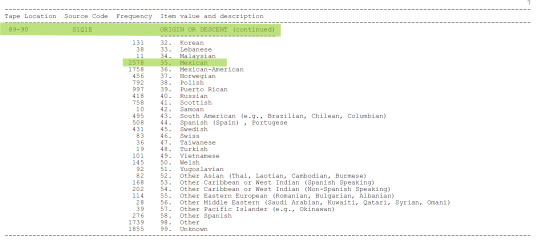




Gracias por tomarse el tiempo de leer mi post, saludos.
1 note
·
View note
Text
First Task
Hi! I'm Maria and i'm currently taking a Data analysis course. I will be working with a data set called NESARC - National Epidemiologic Survey of Drug Use and Health Code Book, trying to answer to the question Are the familiar history of alcoholism and the generalized anxiety related? Taking on account the studies reviewed and the experiment carried out by Merikangas et.al (1998) where they studied the patterns of familial aggregation and co-morbidity of alcoholism and anxiety disorders in the relatives of 165 people selected from treatment programs or at random. The results showed:
"(1) alcoholism was associated with anxiety disorders in the relatives, particularly among females;
(2) both alcoholism and anxiety disorders were highly familial;
(3) the familial aggregation of alcoholism was attributable to alcohol dependence rather than to alcohol abuse, particularly among male relatives; and
(4) the pattern of co-aggregation of alcohol dependence and anxiety disorders in families differed according to the subtype of anxiety disorder"
Considering that information, the expected result is a positive relation between the variables selected (mentioned before).
If you want to know more about the article I mentioned you can purchase it at: https://www.cambridge.org/core/journals/psychological-medicine/article/abs/comorbidity-and-familial-aggregation-of-alcoholism-and-anxiety-disorders/0E13BB54FBE3C6AD7131B6F272FCB06F
Absolutely excited about de process! ^^
1 note
·
View note
Text
Developing a Research question and creating personal codebook. Week 1 Homework
Upon reviewing the codebook for the NESARC study, my focus is primarily on alcohol abuse. I plan to utilize several variables, including the frequency and intensity of alcohol consumption, demographic factors, and lifestyle factors. Additionally, I intend to incorporate all relevant variables into my personal codebook for this research. I have printed following pages, 30,46,77, 125, 299, 316 so far and will print more as needed.
My topic is, “Association between alcohol abuse and chronic depression.”
While alcohol abuse serves as a solid initial focus, I recognize the necessity of clarifying my specific interests within this domain. After careful consideration, I find myself particularly intrigued by the relationship between the amount of alcohol consumed and the development of alcohol dependence. To facilitate this exploration, I augment my codebook to include variables that capture alcohol levels, such as frequency and intensity of alcohol consumption, as well as quantity and frequency. My second topic of interest revolves around the question, "What is the threshold at which a person becomes alcohol dependent?"
The article, “Alcohol consumption and major depression in the general population: the critical importance of dependence” emphasizes on the relationship between alcohol consumption and major depression. It is based on a longitudinal study of a large population cohort in Canada over 12 years. It evaluates different patterns of alcohol use and major depressive episodes (MDEs) using the Composite International Diagnostic Interview Short Form (CIDI-SF). The study found that respondents with alcohol dependence were at higher risk of MDE, but any alcohol consumption, exceeding guidelines for moderate drinking and binge drinking were not Respondents with MDE showed no increase of alcohol consumption, but the risk of alcohol dependence was elevated in depressed men.
The second article titled "Gender Differences in the Relation between Depressive Symptoms and Alcohol Problems: A Longitudinal Perspective" investigates the longitudinal relationship between depressive symptoms and alcohol problems, specifically focusing on gender differences. The study aims to clarify and extend previous research by examining whether depressive symptoms predict subsequent alcohol problems for females, while alcohol problems predict subsequent depressive symptoms for males. Overall, the study adds to the existing literature on the comorbidity of depression and alcohol problems and underscores the significance of considering gender-specific factors in understanding these relationships. It encourages further research in this domain to provide more comprehensive insights into the dynamic interplay between depressive symptoms and alcohol problems over time.
References:
Bulloch, A., Lavorato, D., Williams, J. & Patten, S. (2012). Alcohol consumption and major depression in the general population: the critical importance of dependence. Depress Anxiety, 29(12), 1058. 10.1002/da.22001.
Moscato, B. S., Russell, M., Zielezny, M., Bromet, E., Egri, G., Mudar, P., & Marshall, J. R. (1997). Gender Differences in the Relation between Depressive Symptoms and Alcohol Problems: A Longitudinal Perspective. American Journal of Epidemiology, 146(11), 966-974.
There is a positive association between alcohol abuse and chronic depression. Individuals who engage in higher levels of alcohol abuse, as indicated by increased frequency and intensity of alcohol consumption, are more likely to experience chronic depression compared to those with lower levels of alcohol abuse.
3 notes
·
View notes
Text
🧠 Chi-Square Realness: Alcohol vs. Marital Status 🍷💔💍
Using data from the NESARC survey, we dug into how your relationship status might influence how much you drink. The stats? Unfiltered and telling.
📊 Key Insight:
There’s a significant association between marital status and alcohol consumption (Chi² = 392.18, p < .001).
Married individuals top the charts across all drinking levels.
Divorced/Separated drink moderately — but steadily.
Never Married lean toward lighter drinking, but mid-range isn't rare.
Widowed appear quietly in higher consumption brackets. (Coping, perhaps?)

⚖️ Pairwise Comparisons:
We broke it down further with post-hoc testing:
Married vs Never Married → Big difference (p < .001)
Married vs Divorced/Cohabiting → Still distinct (p < .01)
Never Married vs Separated → Subtle, yet significant (p ≈ .015)



Your marital status might be quietly shaping your drinking habits — whether you're toasting to love, numbing the breakup, or just navigating life solo. In case you want to try the code yourself ````````````````````````
import pandas as pd import numpy as np import scipy.stats as stats import seaborn as sns import matplotlib.pyplot as plt
Load the dataset
data = pd.read_csv('nesarc.csv', low_memory=False)
Convert variables to numeric
data['S2AQ8A'] = pd.to_numeric(data['S2AQ8A'], errors='coerce') # Alcohol frequency data['MARITAL'] = pd.to_numeric(data['MARITAL'], errors='coerce') # Marital status
Subset data (assuming sub1 already exists — else, create one)
sub1 = data.copy() sub2 = sub1.copy()
Replace invalid or missing codes with NaN
sub2['S2AQ8A'].replace([99, np.nan], np.nan, inplace=True) sub2['MARITAL'].replace(9, np.nan, inplace=True)
Filter only valid values
sub2 = sub2[(sub2['S2AQ8A'].between(1, 10)) & (sub2['MARITAL'].between(1, 6))]
Create a label-friendly MARITALSTATUS column (you can use actual labels instead of scores)
marital_map = { 1: 'Married', 2: 'Cohabiting', 3: 'Widowed', 4: 'Divorced', 5: 'Separated', 6: 'Never Married' } sub2['MARITALSTATUS'] = sub2['MARITAL'].map(marital_map)
-------------------------
🔍 Main Chi-Square Test
-------------------------
ct_main = pd.crosstab(sub2['S2AQ8A'], sub2['MARITALSTATUS']) print("Main Contingency Table:\n", ct_main)
print("\nColumn Percentages:\n", ct_main / ct_main.sum(axis=0))
chi2, p, dof, expected = stats.chi2_contingency(ct_main) print("\nChi-square test results:") print(f"Chi2 Value: {chi2:.2f}") print(f"p-value: {p:.4f}") print(f"Degrees of Freedom: {dof}") print("Expected Counts:\n", pd.DataFrame(expected, index=ct_main.index, columns=ct_main.columns))
-------------------------
📊 Visualization
-------------------------
plt.figure(figsize=(12, 6)) sns.countplot(data=sub2, x='MARITALSTATUS', hue='S2AQ8A', palette='Set2') plt.title("Drinking Frequency by Marital Status") plt.xlabel("Marital Status") plt.ylabel("Count of Respondents") plt.legend(title="Drinking Frequency Code", bbox_to_anchor=(1.05, 1), loc='upper left') plt.tight_layout() plt.show()
-------------------------
🔁 Optional: Pairwise Comparisons
-------------------------
def chi_square_pairwise(df, group_col, compare_col, groups): sub_df = df[df[group_col].isin(groups)] ct = pd.crosstab(sub_df[compare_col], sub_df[group_col]) chi2, p, dof, expected = stats.chi2_contingency(ct) print(f"\nChi-square for {groups[0]} vs {groups[1]}") print(f"Chi2: {chi2:.2f}, p-value: {p:.4f}, DOF: {dof}") print("Contingency Table:\n", ct)
Run pairwise tests
pairwise_groups = ('Married', 'Never Married'), ('Married', 'Divorced'), ('Married', 'Cohabiting'), ('Never Married', 'Separated')
for g1, g2 in pairwise_groups: chi_square_pairwise(sub2, 'MARITALSTATUS', 'S2AQ8A', [g1, g2])
````````````````````````
1 note
·
View note
Text
Ethnicity, Alcohol Dependence, and Liver Health: A Revealing Association?
I am French-speaking.
Dataset Selection
For this project, I chose to use the NESARC Wave 1 dataset (National Epidemiologic Survey on Alcohol and Related Conditions). It is particularly relevant because it includes:
Detailed demographic information (race, ethnicity, income, age, etc.),
A DSM-IV diagnosis of alcohol dependence,
Medical data including history of liver and heart diseases.
Research Question and Hypothesis
Research Question:
Is there a link between ethnicity, alcohol dependence, and the prevalence of liver disease among Americans aged 17 and older?
Hypothesis:
I believe that alcohol dependence is strongly associated with liver disease risk, and that this risk varies by ethnicity.
In particular, individuals of Hispanic or European descent with high alcohol dependence are more likely to develop liver disease than those of African American descent.
Literature Review
Identified Scientific References (2 points)
Grant BF et al. (2004) – Prevalence and co-occurrence of substance use disorders and independent mood and anxiety disorders. ➤ Archives of General Psychiatry, 61(8):807–816 ➤ DOI: 10.1001/archpsyc.61.8.807
Rehm J, Roerecke M. (2013) – Alcohol use and risk of liver cirrhosis: a systematic review and meta-analysis. ➤ American Journal of Gastroenterology ➤ Shows a dose-response relationship between alcohol and cirrhosis.
Chartier K et al. (2016) – Ethnicity and health disparities in alcohol research. ➤ Alcohol Research: Current Reviews ➤ Examines ethnic differences in the health impacts of alcohol use.
Summary of Findings and Variables Considered:
Chronic alcohol use and alcohol dependence are causally linked to liver diseases (including steatosis, alcoholic hepatitis, and cirrhosis).
Significant differences across ethnic groups have been observed in the prevalence and treatment of these conditions.
The conceptual model of this project plans to test an interaction effect between ethnicity and alcohol dependence on liver disease risk, while controlling for age and income.
Personal Codebook
S1Q1E, S13Q6A9, S13Q6B9, S13Q6A7, S13Q6B7, S13Q6A8, S13Q6B8
✅ Conclusion
Through this project, I aim to highlight the link between biological and social factors (ethnicity, alcohol dependence) and a major public health issue: liver and heart disease. It is based on a robust dataset (NESARC) and a rich body of literature. The planned analysis will produce significant and actionable results.
1 note
·
View note
Text
Asociación del consumo de alcohol en la adolescencia y el trabajo en la vida adulta
Regresión logística
Introducción
Para esta actividad, se utilizó la base de datos del NESARC con la siguiente pregunta de investigación: ¿Qué efecto tiene la edad de inicio del consumo de alcohol en la situación laboral en la vida adulta?
La variable explicativa fue la edad de inicio del consumo de alcohol (S2BQ2D, cuantitativa) y se categorizó (Edad_cat, categórica), con los siguientes valores:
0: Preadolescentes (11 - 13 años)
1: Adolescentes tempranos (14 -16 años)
2: Adolescentes tardios (17 - 19 años)
La variable de respuesta fue si la persona trabaja en la actualidad (S1Q9C, categórica) y se transformó en una variable nominal (S1Q9C_cat2, nominal), con los siguientes valores:
0: No trabaja actualmente
1: Trabaja actualmente (incluye empleo gubernamental, no gubernamental y otras categorías)
Se incluyeron las siguientes covariables:
Sexo (SEX)
Consumo de drogas (DGSTATUS)
Grado de estudios categorizada (S1Q6A_Group)
Además, se exploraron otras variables, como la ascendencia y la región de residencia, pero no fueron significativas en el análisis bivariado.
Librerías y variables utilizadas


Regresión Logística entre la edad de consumo de alcohol y el trabajo actual

Regresión Logística entre la edad de consumo de alcohol y el trabajo actual y agregando variables para observar confusión.
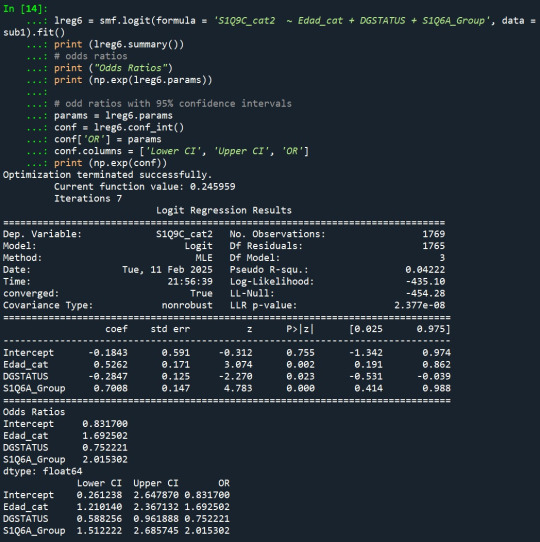
Regresión Logística entre la edad de consumo de alcohol y el trabajo actual y covariables significativas.
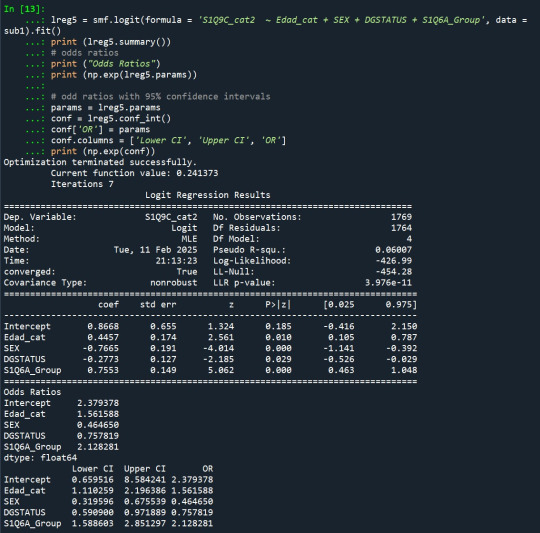
Conclusión
El modelo de regresión logística evalúa el efecto de la edad de inicio del consumo de alcohol en la probabilidad de trabajar en la adultez, controlando por consumo de drogas y nivel educativo.
Los resultados indican lo siguiente:
1. Edad de inicio del consumo de alcohol (Edad_cat)
OR = 1.69 (IC 95%: 1.21 - 2.37, p = 0.002)
Esto sugiere que a medida que la edad de inicio del consumo de alcohol sea mayor, la probabilidad de estar empleado también aumenta en un 69% en comparación con el grupo de referencia, controlando por las demás variables.
2. Consumo de drogas (DGSTATUS)
OR = 0.75 (IC 95%: 0.58 - 0.97, p = 0.023)
Indica que el consumo de drogas reduce la probabilidad de estar empleado en un 25%, en comparación con aquellos que no consumen drogas.
Nivel educativo (S1Q6A_Group)
OR = 2.02 (IC 95%: 1.51 - 2.69, p < 0.001)
Un mayor nivel educativo más alto tiene la probabilidad de estar empleado en la adultez en comparación con el grupo de referencia.
Comprobación de hipótesis
Los resultados indican que la edad de inicio del consumo de alcohol influye en la situación laboral en la adultez. Específicamente, comenzar a beber alcohol a una edad más tardía se asocia con una mayor probabilidad de estar empleado en comparación con aquellos que inician a una edad más temprana.
Además, factores como el consumo de drogas y el nivel educativo también desempeñan un papel importante: mientras que el consumo de drogas reduce las probabilidades de empleo, un mayor nivel educativo las incrementa.
Dado que la variable Edad_cat es significativa y su intervalo de confianza no cruza el valor 1, se comprueba la hipótesis de que la edad de inicio del consumo de alcohol tiene un efecto en la situación laboral en la adultez.
0 notes